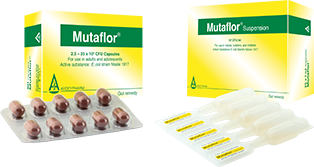Some more Mechanism of Action
E. coli strain Nissle 1917 forms short-chain fatty acids from fiber substances
EcN is to a greater extent capable of forming short-chain fatty acids (formic, acetic, propionic, and butyric acid) from fiber substances. Acetic acid is predominant among these acids. It stimulates the ring musculature of the colon and promotes the blood circulation of the mucosa. Acetic acid consequently has a stimulating effect on intestinal motility. 30 The efficacy of EcN, for example, in cases of chronic obstipation seems to be based on this action. In addition, the bacterial fermentation products, particularly butyric acid, are very energy-rich and indispensable to metabolism in the epithelium of the colon.
Defensins strengthen the body's innate immune defenses
Defensins are the body's own antimicrobial peptides which are produced, for example, in the intestinal epithelium. They are part of the non-specific innate immune system and protect the body against a large number of pathogenic microorganisms. EcN induces the formation of human β-defensin-2 (HBD-2) in intestinal epithelium cells and thus strengthens the body's defense capacity. 13; 24
E. coli strain Nissle 1917 protects against infections
EcN enhances the in-vitro cytotoxicity of isolated murine macrophages against Leishmania donovani. This speaks in favor of a reinforcement of the defense against intracellular parasites. 33
In animal studies, the oral administration of EcN was shown to protect against systemic infections with Candida albicans and Listeria monocytogenes. In animals infected with Candida albicans, a drastic reduction of the microbial contamination of the main target organ, i. e. the kidney, was achieved. A comparable effect was observed in the livers and spleens of animals infected with L. monocytogenes. 344
The healthy gut microbiota prevents against atopic diseases
The microbiota of the gut has an influence on the immune reactions regulated by TH1-lymphocytes and TH2-lymphocytes. A disturbed balance among the various helper-T-cells subsets appears to be responsible for the increased occurrence of atopic diseases. 8 Immunological studies dealing with the colonization of EcN in newborns have shown that the development of the infant's immune system is stimulated. 35 This may also be coupled with a reduction of the risk of developing an allergy.
Intestinal microbiome and the risk of acute infectious respiratory diseases
Acute respiratory infections (ARI) are one of the mayor public health problems and a leading cause of mortality in children under five years of age, worldwide. Indeed, in the US, bronchiolitis accounts for 18% of all infant hospitalizations.65
In the study presented by Aryayev et al. (2018) 66, acute rhinitis, acute rhinopharyngitis, acute bronchitis, acute bronchiolitis, and pneumonia were regarded as ARI. To explore the impact of the intestinal microbiome on distal immunity and respiratory diseases, late preterm newborns received 1 ml Mutaflor Suspension, containing 108 colony forming units of E. coli strain Nissle 1917 (EcN) per milliliter, during the first 7 days of life, and 1 ml of the same suspension three times a week from day 8 to 21. The primary variable to assess efficacy of EcN was the number of participants with at least one acute respiratory infection during the newborn phase, i.e. during the first 28 days of life. In addition, to clarify a possible long-term effect of EcN application on infant immunity, all measures were also taken at the ages of 6 and 12 months.
The study results show, that treatment of late preterm newborns with EcN suspension reduced infant's risk to suffer from ARI during the first 28 days of life by 77% in comparison to children that remained untreated.
8) Rasche C et al. Differential immunomodulating effects of inactivated probiotic bacteria on the allergic immune response. Acta Derm Venereol 2007; 87: 305–311.
13) Schlee M et al. Induction of human beta-defensin 2 by the probiotic Escherichia coli Nissle 1917 is mediated through flagellin.Infect Immun 2007; 75(5): 2399–2407.
24) Wehkamp J et al. NF-kappaB- and AP-1-mediated induction of human beta defensin-2 in intestinal epithelial cells by Escherichia coli Nissle 1917: a novel effect of a probiotic bacterium. Infect Immun 2004; 72(10): 5750–5758.
30) Bär F et al. Cell-free supernatants of Escherichia coli Nissle 1917 modulate human colonic motility: evidence from an in vitro organ bath study. Neurogastroenterol Motil 2009; 21: 559-e17.
33) Hockertz S. Immunmodulierende Wirkung von abgetöteten apathogenen Escherichia coli Stamm Nissle 1917, auf das Makrophagensystem. Arzneim-Forsch/Drug Res 1991;41:1108–1112.
34) Hockertz S. Steigerung der körpereigenen Abwehr gegen Bakterien- und Pilzinfektionen bei Mäusen nach Vorbehandlung mit dem apathogenen Escherichia coli-Stamm Nissle 1917. Arzneim.-Forsch./Drug Res. 1997;47(I)(6): 793–796.
35) Lodinová-Žádníková R et al. Local and serum antibody response in fullterm and premature infants after artificial colonization of the intestine with E. coli strain Nissle 1917 (Mutaflor). Pediatr Allergy Immunol 1992; 3: 43–48.
65) Hasegawa K, Tsugawa Y, Brown DF, Mansbach JM, Camargo CA Jr. Trends in bronchiolitis hospitalizations in the United States, 2000–2009. Pediatrics. 2013;132(1): 28–36.
66) Aryayev ML, Senkivska LI, Bredeleva NK, Talashova IV. Prophylaxis of acute respiratory infections via improving the immune system in late preterm newborns with E. coli strain Nissle 1917: a controlled pilot trial. Pilot Feasibility Stud. 2018; 4: 79.
doi: 10.1186/s40814-018-0271-y. eCollection 2018.
www.ncbi.nlm.nih.gov/pmc/articles/PMC5911946/
